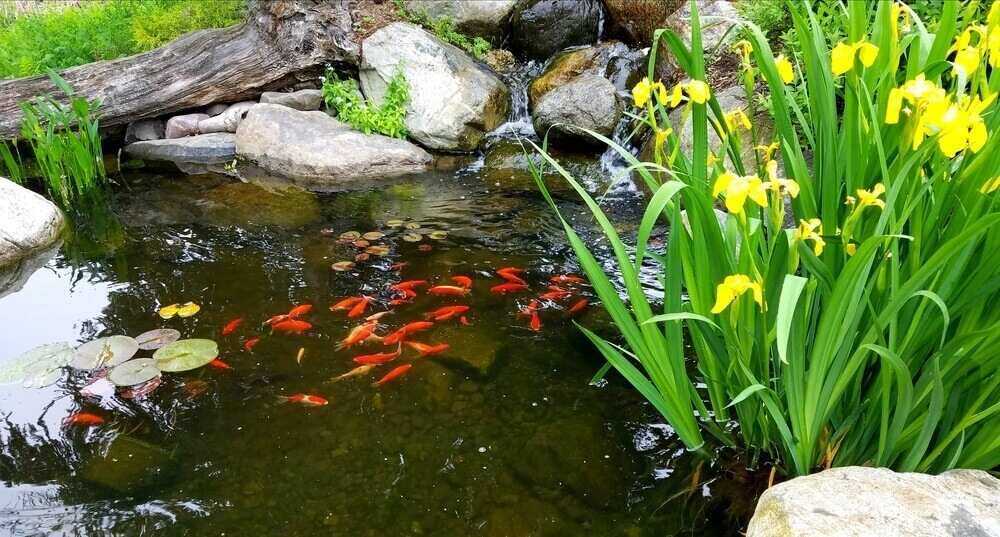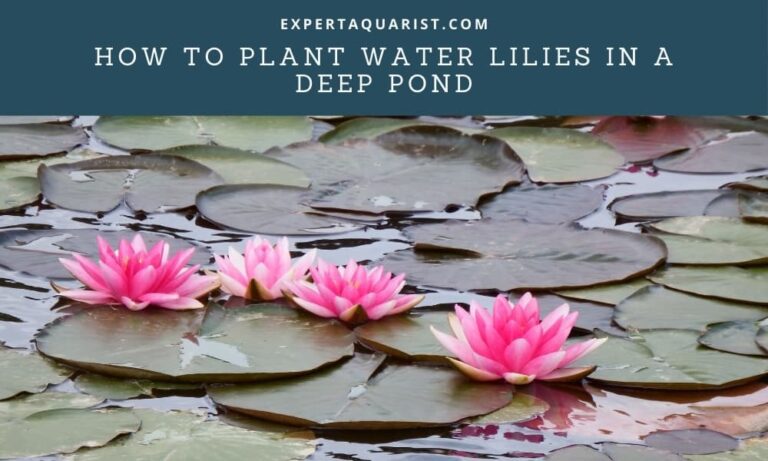A koi pond can transform your backyard and promote tranquility. If you are an aquarist, they are also great for koi fish farming. A well-thought-out design of the pond enhances its functionality and boosts its aesthetics.
You can include a wide range of design elements in your koi pond to make it unique. Below are the top 7 design ideas to create a unique backyard koi pond garden.

1. Koi Pond With Water Features
Koi ponds have a particular design whereby you should not include rocks, aquatic plants, and gravel as they could harm the koi fish. However, you can incorporate various water features into your koi pond, including waterfalls, fountains, and spitters. These features not only boost the aesthetics of the pond but are also functional.
For instance, a waterfall can help improve circulation by boosting water movement. It also inhibits algae growth. Furthermore, the cascading sound of the water is soothing for you and the fish.
However, the waterfall should not be installed as part of the filtration system, as in the case of water garden ponds or hybrid ponds. Consider if you want a gentle spillway or a more natural flow when installing.
Go for a waterfall kit compatible with your koi pond design and with all the necessary components. Other factors to consider when installing a waterfall in a koi pond include the width and elevation, angle of tubing, and length.
Waterfalls are expensive and more complex to install. Therefore, if you are looking for a cheaper and simple option, go for a fountain. Like waterfalls, fountains are both functional and decorative. They promote aeration in the koi pond.
You can purchase various parts separately or a complete fountain kit. A fountain requires a pump to push water through the fountainhead. If buying the fountain parts separately, ensure that the pump is compatible.
Another great option for koi pond water features is spitters. They add personality to your pond and are easy to install.
There is a wide range of designs and sizes to choose from to suit your pond size and exterior decor. They require compatible piping and, in some cases, a pump. To install, simply find a spot, fit the pump and attach the spitter.
2. Lights in Koi Pond
Installing underwater lights in a koi pond boosts its ambiance, especially at night. It illuminates the fish making their vibrant colors pop out more. Yet, the lighting does not disrupt the koi fish resting pattern.
That said, put some thought into choosing the underwater light regarding the color of the light, intensity, and type of bulb.
White fluorescent bulbs are the most commonly used as they are cheap and readily available. They are best suited for use on the dockside. They attract fish, enabling them to regroup near the dockside for a spectacular view.
Green light adds a unique flare to your pond but does not attract the fish. Red bulbs also add flare to the pond and do not distract the fish. They are great for fishing as they provide good human visual sight.
Blue lighting is best suited for murky water. Black light provides good visibility and makes the fish glow. However, they are quite expensive. White LED light is durable but expensive. On the downside, white and green lights tend to attract bugs.
Koi fish tend to be quite active in the evening. Therefore, you can put the lights on early evening and then put them off later.

3. Plant Trees Around the Koi Pond
Although aquatic plants are discouraged inside the koi pond, planting trees around the pond offers numerous benefits.
It creates a calm ambiance, especially on hot days, as they provide shading. The roots prevent bank erosion and soak up excess nutrients, which could cause an imbalance in the water parameters.
Furthermore, you can hang a hammock between the tree and near the pond to enjoy the view and calming ambiance.
However, there are considerations to make when planting trees near a koi pond. First, not all trees are safe for koi ponds. For example, a walnut tree’s fruits, leaves, and nuts are toxic to fish. Other toxic plants for koi fish include buckthorn, Ginko, and cherry.
Keep in mind that the foliage adds waste to the pond, which can result in nutrient build-up and excessive algae growth. Therefore, avoid trees that shed too many leaves and regularly clean your koi pond to get rid of the falling leaves.
Also, as the roots develop, they may puncture the pond liner. To prevent this, use a rubber liner or place clay blocks around the liner to block the roots.
Some of the best trees to plant around a koi pond include juniper, willow, dogwood, red maple, etc.
4. Introduce Other Animals or Fish Into the Koi Pond
Including other animals and fish in the koi pond adds an aspect of biodiversity and creates a sustainable ecosystem.
However, it can be challenging to identify the most suitable pond mates for koi fish, especially because koi fish require specific water depth, water pH, pond size, and weather conditions.
Since they can live up to 40 years, they are the focal point of the pond. Therefore, when adding pond mates, they have to fit into the koi fish water settings.
Another factor to consider is that some animals and fish can bring diseases into the koi pond. Also, koi can be aggressive to smaller species such as mollies, danios, and guppies. They are opportunistic omnivores and may eat smaller fish if put together.
Some of the best pond mates for koi fish include grass carp, goldfish, redear sunfish, largemouth bass, and janitor fish, among others. You can also incorporate turtles and ducks.
5. Brick Bottom Koi Pond
A brick bottom koi pond makes the fish, particularly white koi, stand out for a stunning view. Although bricks are generally safe for the fish, they pose various challenges when used as the bottom for a koi pond.
Red brick is the most common option for constructing the edges of a backyard pond. Putting them at the bottom of the pond makes them prone to cracking, as clay tends to freeze in low temperatures.
Engineering bricks are better suited for use at the bottom of the koi pond. They have the same vibrant color but are tougher and more resistant to damage.
Another challenge with using bricks at the bottom of the koi pond is that some of the clay may be absorbed into the water altering the pond’s pH.
To avoid this, leave new concrete bricks in the open for several months before using them for construction. Doing so ages the blocks to ensure the material does not affect the water’s pH. Also, do not stain or paint the blocks.

6. Bridge Over the Pond
This is a great design option for both small and large backyards. The bridge creates a focal point for an up-close view of the koi pond. The bridge can be installed in the middle across the pool if the koi pond is significantly big.
It provides koi with hiding spots against the sun or predators. It also makes maintenance of a large pond easier as it gives you access to the center, which you would otherwise not reach from the far sides of the pond.
There is a wide range of garden bridge designs to choose from for your fish pond. For instance, while some are flat, others have a small arc, yet others have a miniature design.
You could also choose a flat or arched bridge without railings. Some people opt for a stepping stone bridge with stones laid across the pond.
With basic carpentry and DIY skills, you can build the bridge yourself. There are numerous easy-to-assemble garden bridges for sale on Amazon. Choose a design, size, and material you like.
Pay attention to the weight capacity of the bridge and whether it is treated to ensure it is weather resistant. Material options include different types of wood or metal.
Once your garden bridge is delivered, follow the assembly instructions provided to set it up. You may also customize it by painting it your preferred color.
Alternatively, buy the necessary items and build a bridge if you have intermediate to advanced carpentry skills. Or, hire a professional to build one for you.
7. Large Koi Pond
Typically, the ideal size for a koi pond depends on the number and size of fish you want to keep. However, consider installing a large koi pond if you have a large backyard. It is a great option also if you want to keep many koi fish or a variety of koi fish.
A large koi fish pond also allows you to incorporate a wide range of water features. You can also incorporate multiple design elements such as those discussed above, e.g., fountain, waterfall, sculptures, lights, bridge, animals, and plants.
However, a larger koi fish pond is more expensive to install and maintain. Typically, a small koi pond measuring 7 feet by 11 feet costs $5,000 and $6,000 to install.
Mid-size ponds measuring 10-15 feet by 12-20 feet cost $10,000 to $20,000. While larger koi ponds cost $50,000 and above. Their maintenance will also be more extensive and time-consuming.
Conclusion
Koi fish are beautiful and boost the ambiance of your outdoors and backyard pond. Their vibrant colors and movements are calming.
You can further boost the aesthetics of your backyard koi pond by incorporating some of the design ideas discussed above.






